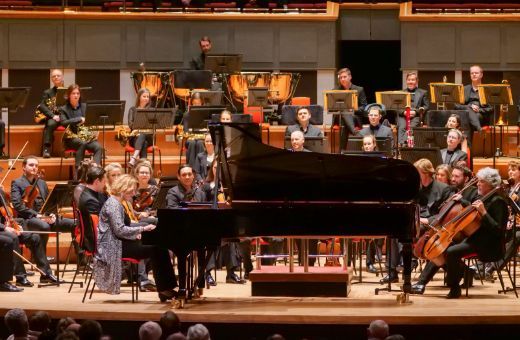Gabriela Montero returned to Birmingham last night to deliver a mesmerising performance of Tchaikovsky’s Piano Concerto no.1 in B flat major at Symphony Hall. With the concerto being so well-known, the challenge for any soloist is to add interest to familiarity and this is where Montero distinguishes herself. There is a sense of discovery in every phrase, as if she is interpreting the piece on the fly.

No matter how well the notes had settled into her muscle memory, there was something in the moment that made this performance unique from countless others. It was a sense of discovery that encouraged a responsiveness from the City of Birmingham Symphony Orchestra and its baton-wielding musical director Mirga Gražintyė-Tyla, a responsiveness that kept the audience captivated from start to finish. Any looseness in the orchestral performance was the result of its spontaneity and it was that which provided the interest and kept me on tenterhooks. Montero’s touch was like runny honey, golden and sweet and natural, particularly in the sublime cadenza at the end of the first movement. Montero returns to Symphony Hall tonight for a further performance (this time with Brahms Symphony no. 3 on the programme instead of Bruckner 6), and one anticipates that tonight's recital will be just as fresh and spontaneous and responsive as last night's, yet equally unique.
Even if one were to accept the criticism of under-rehearsal of the concerto, the same criticism would not be justified in respect of the performance of Anton Bruckner’s Symphony no. 6 in A major. The CBSO were at their very best. The balance of sound was close to perfection, from the strident harmonies of the brass chorus to the delicate pairings in the woodwind. The strings of the CBSO were faultless, the French horns were wonderfully melodious and the timpani mightily thunderous in various crescendi. Mirga Gražintyė-Tyla controlled the orchestra effortlessly, driving the big thematic refrains with gusto, yet dropping the dynamics so dramatically that the effect was as physical as it was aural, as one caught one’s own breathing.
The first movement was sensational, the strings creating the understated tension of the main theme, which was then picked up by the brass, replete with rotary trumpets for the more authentic Germanic sound. The Adagio featured some well-tempered woodwind, with a plaintive oboe tone that stood out for its beauty, while the scherzo pulsated with the energy of a race horse. But what made the performance so effective was not the individual features of the instrumentation or the delivery of isolated sections. This was a unified and tightly knit CBSO that was working closely with the baton of the conductor, and a conductor who knew exactly what she wanted from Bruckner and how to get it. Gražintyė-Tyla delivered a grand and faultless performance in her final UK concert as the CBSO's Music Director.


